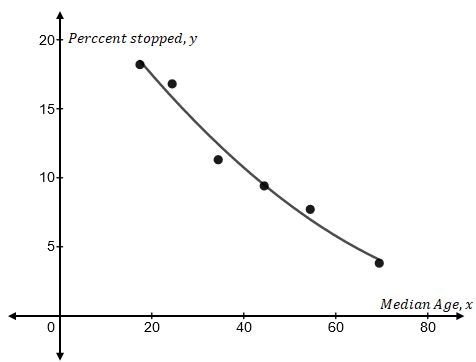
Concept explainers
The following data represent the percent of all drivers by age who have been stopped by the policy for any reason within the past year. The median age represents the midpoint of the upper and lower limit for the age range.
Using a graphing utility, draw a
Determine a model that best describes the relation between median age and percent stopped. You may choose from among linear, quadratic, cubic, exponential, logarithmic, and logistic models.
Provide a justification for the model that you selected in part (b).
(a)
To graph: The scattered plot of given data using graphing utility by treating median age
Explanation of Solution
Given information:
The table
Graph:
Step-1: Plug the median price,
Step-2: Go to
Step-3: Click on
Therefore, the scattered plot of the given data is

Interpretation:
The scattered plot is showing behavior like graph of the quadratic function. Therefore, the relation between median price,
(b)
The best fit model that describes the relation between values of the median price,
Answer to Problem 15CR
Solution:
The best fit function for data is
Explanation of Solution
Given information:
The table
Explanation:
To find the equation of the best fit model for this data using graphing calculator press
Therefore, the best fit function for the given data is
(c)
The justification for the model for the given data. The table is
Answer to Problem 15CR
Solution:
Justification: As the graph of the quadratic function shows similar behavior like the scattered plot, that is why, the quadratic function is the best fit function for this given data values.
Explanation of Solution
Given information:
The data is
Explanation:
Graph the scattered plot and the best fit function
In the graphing calculator, press
Then, click on
That gives the graph,

As the graph of the quadratic function shows similar behavior like the scattered plot, that is why, the quadratic function is the best fit function for this given data values.
Chapter 5 Solutions
Precalculus
Additional Math Textbook Solutions
Basic Business Statistics, Student Value Edition
Elementary Statistics
University Calculus: Early Transcendentals (4th Edition)
A Problem Solving Approach To Mathematics For Elementary School Teachers (13th Edition)
Elementary Statistics (13th Edition)
Elementary Statistics: Picturing the World (7th Edition)
- please do Q3arrow_forwardUse the properties of logarithms, given that In(2) = 0.6931 and In(3) = 1.0986, to approximate the logarithm. Use a calculator to confirm your approximations. (Round your answers to four decimal places.) (a) In(0.75) (b) In(24) (c) In(18) 1 (d) In ≈ 2 72arrow_forwardFind the indefinite integral. (Remember the constant of integration.) √tan(8x) tan(8x) sec²(8x) dxarrow_forward
- Find the indefinite integral by making a change of variables. (Remember the constant of integration.) √(x+4) 4)√6-x dxarrow_forwarda -> f(x) = f(x) = [x] show that whether f is continuous function or not(by using theorem) Muslim_mathsarrow_forwardUse Green's Theorem to evaluate F. dr, where F = (√+4y, 2x + √√) and C consists of the arc of the curve y = 4x - x² from (0,0) to (4,0) and the line segment from (4,0) to (0,0).arrow_forward
- Evaluate F. dr where F(x, y, z) = (2yz cos(xyz), 2xzcos(xyz), 2xy cos(xyz)) and C is the line π 1 1 segment starting at the point (8, ' and ending at the point (3, 2 3'6arrow_forwardCan you help me find the result of an integral + a 炉[メをメ +炉なarrow_forward2 a Can you help me find the result of an integral a 아 x² dxarrow_forward
 Calculus: Early TranscendentalsCalculusISBN:9781285741550Author:James StewartPublisher:Cengage Learning
Calculus: Early TranscendentalsCalculusISBN:9781285741550Author:James StewartPublisher:Cengage Learning Thomas' Calculus (14th Edition)CalculusISBN:9780134438986Author:Joel R. Hass, Christopher E. Heil, Maurice D. WeirPublisher:PEARSON
Thomas' Calculus (14th Edition)CalculusISBN:9780134438986Author:Joel R. Hass, Christopher E. Heil, Maurice D. WeirPublisher:PEARSON Calculus: Early Transcendentals (3rd Edition)CalculusISBN:9780134763644Author:William L. Briggs, Lyle Cochran, Bernard Gillett, Eric SchulzPublisher:PEARSON
Calculus: Early Transcendentals (3rd Edition)CalculusISBN:9780134763644Author:William L. Briggs, Lyle Cochran, Bernard Gillett, Eric SchulzPublisher:PEARSON Calculus: Early TranscendentalsCalculusISBN:9781319050740Author:Jon Rogawski, Colin Adams, Robert FranzosaPublisher:W. H. Freeman
Calculus: Early TranscendentalsCalculusISBN:9781319050740Author:Jon Rogawski, Colin Adams, Robert FranzosaPublisher:W. H. Freeman
 Calculus: Early Transcendental FunctionsCalculusISBN:9781337552516Author:Ron Larson, Bruce H. EdwardsPublisher:Cengage Learning
Calculus: Early Transcendental FunctionsCalculusISBN:9781337552516Author:Ron Larson, Bruce H. EdwardsPublisher:Cengage Learning





